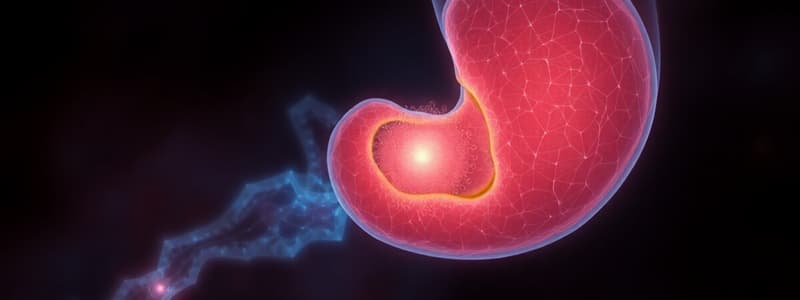Podcast
Questions and Answers
At what stage does the trophoblast develop into a tertiary villus?
At what stage does the trophoblast develop into a tertiary villus?
- Beginning of the fourth week
- Beginning of the second week
- End of the third week (correct)
- Beginning of the third week
The cytotrophoblastic cells in the villi do not establish contact with the maternal endometrium.
The cytotrophoblastic cells in the villi do not establish contact with the maternal endometrium.
False (B)
What structure connects the embryo to the trophoblastic shell?
What structure connects the embryo to the trophoblastic shell?
connecting stalk
The primary villi consist of a cytotrophoblastic core covered by a __________ layer.
The primary villi consist of a cytotrophoblastic core covered by a __________ layer.
Match the following types of villi with their descriptions:
Match the following types of villi with their descriptions:
What is the primary function of the notochord during embryonic development?
What is the primary function of the notochord during embryonic development?
The notochordal canal communicates only with the yolk sac.
The notochordal canal communicates only with the yolk sac.
What structure appears around the 16th day of development and extends into the connecting stalk?
What structure appears around the 16th day of development and extends into the connecting stalk?
The ________ membrane is formed at the caudal end of the embryonic disc and consists of tightly adherent ectoderm and endoderm cells.
The ________ membrane is formed at the caudal end of the embryonic disc and consists of tightly adherent ectoderm and endoderm cells.
Match the following terms with their descriptions:
Match the following terms with their descriptions:
What is the first structure formed by the invagination of prenotochordal cells?
What is the first structure formed by the invagination of prenotochordal cells?
The intra-embryonic mesoderm is found in the prochordal plate.
The intra-embryonic mesoderm is found in the prochordal plate.
What is the first event that occurs during the process of gastrulation?
What is the first event that occurs during the process of gastrulation?
The primitive node is located at the caudal end of the primitive streak.
The primitive node is located at the caudal end of the primitive streak.
What three germ layers are established during gastrulation?
What three germ layers are established during gastrulation?
During gastrulation, cells of the epiblast undergo __________ to become mesoderm.
During gastrulation, cells of the epiblast undergo __________ to become mesoderm.
Match the following terms with their descriptions:
Match the following terms with their descriptions:
Which factor is crucial for cell migration and specification during gastrulation?
Which factor is crucial for cell migration and specification during gastrulation?
The hypoblast contributes to the formation of ectoderm during gastrulation.
The hypoblast contributes to the formation of ectoderm during gastrulation.
What structure determines the cranial and tail end of the embryo?
What structure determines the cranial and tail end of the embryo?
The ________ is a depression located in the center of the primitive node.
The ________ is a depression located in the center of the primitive node.
What change occurs to cells of the hypoblast at the cranial part of the embryonic disc?
What change occurs to cells of the hypoblast at the cranial part of the embryonic disc?
Flashcards
What is gastrulation?
What is gastrulation?
The most significant event during the third week of pregnancy, it establishes the three primary germ layers: ectoderm, mesoderm, and endoderm.
What is the primitive streak?
What is the primitive streak?
A thickened, slightly raised area on the epiblast, marking the beginning of gastrulation.
What is the primitive node?
What is the primitive node?
A slightly elevated region at the cephalic end of the primitive streak, crucial for inducing the development of the notochord.
What is the primitive pit?
What is the primitive pit?
Signup and view all the flashcards
What is invagination?
What is invagination?
Signup and view all the flashcards
What is the endoderm?
What is the endoderm?
Signup and view all the flashcards
What is the mesoderm?
What is the mesoderm?
Signup and view all the flashcards
What is the ectoderm?
What is the ectoderm?
Signup and view all the flashcards
What is FGF8?
What is FGF8?
Signup and view all the flashcards
What is the prochordal plate?
What is the prochordal plate?
Signup and view all the flashcards
What is the notochord?
What is the notochord?
Signup and view all the flashcards
What is the notochordal process?
What is the notochordal process?
Signup and view all the flashcards
What is the notochordal canal?
What is the notochordal canal?
Signup and view all the flashcards
What is the neurenteric canal?
What is the neurenteric canal?
Signup and view all the flashcards
What are prenotochordal cells?
What are prenotochordal cells?
Signup and view all the flashcards
What is the notochordal plate?
What is the notochordal plate?
Signup and view all the flashcards
What is the definitive notochord?
What is the definitive notochord?
Signup and view all the flashcards
What is the syncytiotrophoblast?
What is the syncytiotrophoblast?
Signup and view all the flashcards
What is the cytotrophoblast?
What is the cytotrophoblast?
Signup and view all the flashcards
What is the secondary villus?
What is the secondary villus?
Signup and view all the flashcards
What is the tertiary villus?
What is the tertiary villus?
Signup and view all the flashcards
What is the cytotrophoblastic shell?
What is the cytotrophoblastic shell?
Signup and view all the flashcards
What are stem or anchoring villi?
What are stem or anchoring villi?
Signup and view all the flashcards
What are free or terminal villi?
What are free or terminal villi?
Signup and view all the flashcards
What is the chorionic cavity?
What is the chorionic cavity?
Signup and view all the flashcards
What is the connecting stalk?
What is the connecting stalk?
Signup and view all the flashcards
What is the prochordal plate?
What is the prochordal plate?
Signup and view all the flashcards
What is the cloacal membrane?
What is the cloacal membrane?
Signup and view all the flashcards
Study Notes
Gastrulation
- The most important event during the third week of gestation
- Establishes the three germ layers: ectoderm, mesoderm, and endoderm
- Begins with the formation of the primitive streak on the epiblast
- Primitive streak has a slightly bulging region on either side
- Primitive node is the cephalic end of the streak (slightly elevated area around the primitive pit)
- Primitive pit is a depression in the center of the primitive node
- Cells of the epiblast migrate toward the primitive streak becoming flask-shaped, detaching and slipping beneath it (inward movement called invagination)
- Cells that displace the hypoblast create the embryonic endoderm
- Cells that lie between the epiblast and the endoderm form the mesoderm
- Cells that remain in the epiblast form the ectoderm
- Cell migration and specification are controlled by fibroblast growth factor 8 (FGF8)
- Cells spread laterally and cranially after migrating between the epiblast and hypoblast layers
- The epiblast is the source of all three germ layers
- In the cranial part of the embryonic disc, hypoblast cells become taller and columnar, forming the prochordal plate
- Prochordal plate is a thickening firmly attached to the overlying epiblastic disc on day 14
- The appearance of the prochordal plate determines the embryo's pole and its central axis which becomes the cranial end
- The tail end is on the opposite side
Notochord
- Develops from the upper end of the primitive streak to the lower end of the prochordal plate
- Notochordal process - cells multiply in the midline between the ectoderm and endoderm until they reach the lower end of the prochordal plate (day 17-18)
- Notochordal canal - the primitive pit extends into the notochordal process, converting it into a canal
- Floor of the notochordal canal breaks down
- Notochordal canal communicates with the yolk sac and amniotic cavity through the primitive pit
- Neurenteric canal - temporary connection between amniotic and yolk sac cavities
- Prenotochordal cells invaginate in the primitive node and move cranially in the midline until they reach the prechordal plate
- Notochord and prenotochordal cells extend cranially to the prechordal plate (area just caudal to the oropharyngeal membrane) and caudally to the primitive pit
- Notochordal plate - two-cell layers in the midline of the embryo where prenotochordal cells become intercalated in the hypoblast
- Definitive notochord - solid cord of cells formed by notochordal plate, lies under the neural tube
- Notochord is the basis for the axial skeleton
- Notochord induces the formation of the neural tube
- Notochord persists in the first decade of life as the nucleus pulposus of the intervertebral disc
Trophoblast Development
- By the start of the third week, the trophoblast is characterized by primary villi, which consist of a cytotrophoblastic core covered by a syncytial layer
- Mesodermal cells enter the core of primary villi and grow towards the decidua, forming a secondary villus
- Secondary villus mesodermal cells differentiate into blood cells and small blood vessels, forming the villous capillary system
- Tertiary villus (definitive placental villus) - the villus after developing a capillary system
- Villi capillaries connect with capillaries developing in the chorionic plate mesoderm and the connecting stalk - these vessels connect the placenta and the embryo
- Heart begins to beat in the fourth week of development, allowing the villous system to supply the embryo with nutrients and oxygen
- Cytotrophoblastic cells in the villi penetrate the syncytium until they meet similar extensions from neighboring villous stems (thin outer cytotrophoblast shell)
- The cytotrophoblast shell surrounds the trophoblast and anchors the chorionic sac to the maternal endometrial tissue
- Stem or anchoring villi - extend from the chorionic plate to the decidua basalis (decidual plate)
- Free (terminal) villi - extend from the sides of stem villi and are involved in nutrient exchange
- Chorionic cavity becomes larger by the 19th or 20th day
- The embryo is attached to the shell by a narrow connecting stalk (develops into the umbilical cord)
Intra-embryonic Mesoderm
- Spreads all over the disc except for the prochordal plate
- Prochordal plate is very thin with adherent ectoderm and endoderm, no mesoderm between the layers
- The prochordal plate will later form the buccopharyngeal membrane (oral cavity)
- The cloacal membrane is formed at the caudal end of the embryonic disc - similar structure to the oropharyngeal membrane, with tightly adherent ectoderm and endoderm with no intervening mesoderm.
Intraembryonic Coelom
- Caudal end of the connecting stalk forms a small diverticulum called the allantoenteric diverticulum (allantois) around day 16
- The allantois extends into the connecting stalk
- Mesoderm divides into:
- Somatic mesoderm (parietal mesoderm) - forms lateral body wall.
- Splanchnic mesoderm (visceral mesoderm) - forms wall of viscera.
Studying That Suits You
Use AI to generate personalized quizzes and flashcards to suit your learning preferences.




